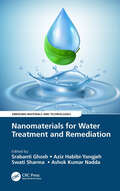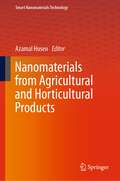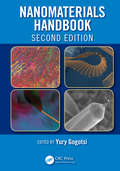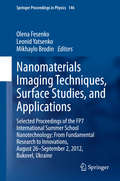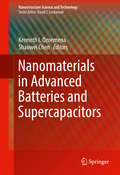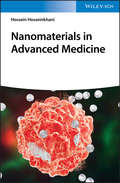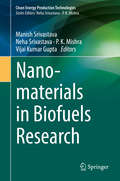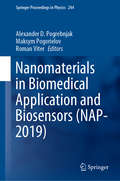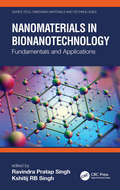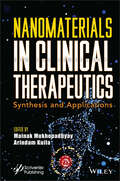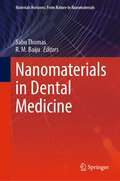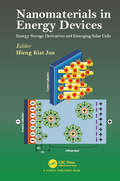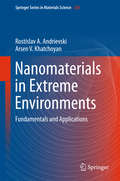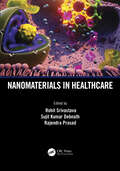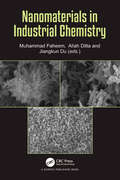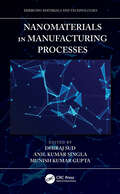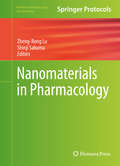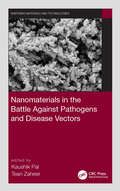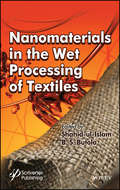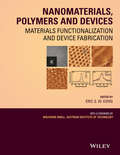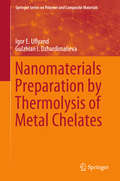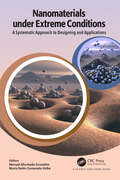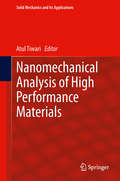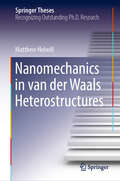- Table View
- List View
Nanomaterials for Water Treatment and Remediation (Emerging Materials and Technologies)
by Srabanti Ghosh Aziz Habibi-Yangjeh Swati Sharma Ashok Kumar NaddaOffering a comprehensive view of water-treatment technologies, Nanomaterials for Water Treatment and Remediation explores recent developments in the use of advanced nanomaterials (ANMs) for water treatment and remediation. In-depth reaction mechanisms in water-treatment technologies, including adsorption, catalysis, and membrane filtration for water purification using ANMs, are discussed in detail. The book includes an investigation of the fabrication processes of nanostructured materials and the fundamental aspects of surfaces at the nanoscale. The book also covers the removal of water-borne pathogens and microbes through a photochemical approach. FEATURES Explains various chemical treatments for the removal and separation of hazardous dyes, organic pollutants, pharmaceuticals, and heavy metals from aqueous solutions, including adsorption, advanced oxidation process, and photocatalysis Discusses the rational design of nanoporous materials with a tunable pore structure and fabrication of nanomaterials by surface chemistry engineering Covers the role of nanomaterials-assisted oxidation and reduction processes, design of nano-assisted membrane-based separation, and multifunctional nanomaterials and nanodevices for water treatment Provides an understanding of the structure–activity relationship and stability of ANMs under critical experimental conditions Identifies potential challenges in the application of multifunctional ANMs for future research Nanomaterials for Water Treatment and Remediation is aimed at researchers and industry professionals in chemical, materials, and environmental engineering as well as related fields interested in the application of advanced materials to water treatment and remediation.
Nanomaterials from Agricultural and Horticultural Products (Smart Nanomaterials Technology)
by Azamal HusenThis book gives a complete overview of current developments in the fabrication and diverse applications of metal and metal oxide nanomaterials synthesized from agricultural/horticultural products and organic waste materials. Nanoparticles are thought to have been present on earth naturally since its origin in the form of soil, water, volcanic dust, and minerals. Besides their natural origin, they have been also synthesized by using physical, chemical, and biological means. The chapters in this book look at agricultural as well as horticultural wastes from industries, such as palm oil, rubber, paper, wood, vegetable, coffee/tea, rice, wheat, maize, grass, and fruit juice processing factories, and describe the methods to extract and synthesize metal and metal oxide nanoparticles, which are then applied in various sectors such as food, agriculture, cosmetics, and medicines industries. The book is a reference source for academician, scientists, policymakers, students, and researchers scientist working in minimizing the environmental pollution and implementing nanotechnology into agricultural waste products to produce eco-friendly and cost-effective nanoparticles.
Nanomaterials from Renewable Resources for Emerging Applications (Emerging Materials and Technologies)
by Sandeep S. Ahankari Amar K. Mohanty Manjusri MisraNanomaterials from Renewable Resources for Emerging Applications details developments in nanomaterials produced from renewable materials and their usage in food and packaging, energy conservation, and environmental applications. • Introduces fundamentals of nanomaterials from renewable resources, including processing and characterization. • Covers nanomaterials for applications in food and packaging, including nanocellulose, lignin- and chitosan-based nanomaterials, and nanostarch. • Discusses applications in energy conservation, such as supercapacitors, electrolyte membranes, energy storage devices, and insulation. • Describes environmental uses such as water remediation and purification and oil spill clean-ups. • Highlights advantages and challenges in commercialization of green nanoparticle-based materials. Equally beneficial to researchers and professionals, this book is aimed at readers across materials science and engineering, chemical engineering, chemistry, and related fields interested in sustainable engineering.
Nanomaterials Handbook (Advanced Materials and Technologies)
by Yury GogotsiThis title features 11 new chapters unique to this edition, including chapters on grain boundaries in graphene, 2D metal carbides and carbonitrides, mechanics of carbon nanotubes and nanomaterials, biomedical applications, oxidation and purification of carbon nanostructures, sintering of nanoceramics, hydrothermal processing, nanofibers, and nanomaterials safety. It offers a comprehensive approach with a focus on inorganic and carbon-based nanomaterials, including fundamentals, applications, synthesis, and characterization. This book also provides a unique angle from the nanomaterial point of view on application, synthesis, and characterization not found in any other nanomaterials book on the market.
Nanomaterials Imaging Techniques, Surface Studies, and Applications: From Fundamental Research to Innovations, August 26-September 2, 2012, Bukovel, Ukraine
by Leonid Yatsenko Mikhaylo Brodin Olena FesenkoThis book presents cutting-edge research on a wide range of nanotechnology techniques and applications. It features contributions from scientists who participated in the International Summer School "Nanotechnology: From Fundamental Research to Innovations" in Bukovel, Ukraine on August 26 - September 2, 2012 funded by the European Commission FP7 project Nanotwinning implemented by the Institute of Physics of National Academy of Sciences of Ukraine and partner institutions: University of Tartu (Estonia), European Profiles A.E. (Greece), University of Turin (Italy) and Université Pierre et Marie Curie (France). Worldwide experts present the latest results on such key topics as microscopy of nanostructures; nanocomposites; nanostructured interfaces and surfaces; nanooptics; nanoplasmonics; and enhanced vibrational spectroscopy. Imaging technique coverage ranges from atomic force microscopy and spectroscopy, multiphoton imagery, and laser diagnostics of nanomaterials and nanostructures, to resonance Raman and SERS for surface characterization, and scanning tunneling microscopy of organic molecules. The breadth of topics highlights the exciting variety of research currently being undertaken in this field and suggests new opportunities for interdisciplinary collaboration and future research.
Nanomaterials in Advanced Batteries and Supercapacitors
by Kenneth I. Ozoemena Shaowei ChenThis book provides an authoritative source of information on the use of nanomaterials to enhance the performance of existing electrochemical energy storage systems and the manners in which new such systems are being made possible. The book covers the state of the art of the design, preparation, and engineering of nanoscale functional materials as effective catalysts and as electrodes for electrochemical energy storage and mechanistic investigation of electrode reactions. It also provides perspectives and challenges for future research. A related book by the same editors is: Nanomaterials for Fuel Cell Catalysis.
Nanomaterials in Advanced Medicine
by Hossein HosseinkhaniA comprehensive and multidisciplinary review of the fundamental concepts and medical applications of nanomaterials development technology Nanomedicine offers a range of multi-interdisciplinary approaches and brings together the field of chemistry, pharmaceutical science, biology, and clinical medicines by focusing on design and preparation of biodegradable or non-biodegradable biomaterials for their biological, medical, and pharmaceutical applications. Nanomaterials in Advanced Medicine reviews the concepts and applications of the combination of the technology of biology and engineering that are emerging as an integral aspect of today?s advanced medicine. Nanomedicine provides the technology for imaging, cancer treatment, medical tools, bone treatment, drug delivery, diagnostic tests, drug development, angiogenesis and aims to exploit the improved and often novel physical, chemical, and biological properties of materials at the nanometer scale. Designed to provide a broad survey of the field, Nanomaterials in Advanced Medicine is divided into three main sections: Nanophysics, Nanochemistry, and Nanomedicine. Each chapter describes in detail the most current and valuable methods available and contains numerous references to the primary literature. This important book: -Offers a field guide for biologists and physicians who want to explore the fascinating world of nanotechnology -Contains a comprehensive review of the topic from a noted expert in the field -Includes an introduction to nanotechnology and explores the synthesis, structure and properties of various types of nanobiomaterials -Bridges the gap between various aspects of nanomaterials? development technology and their applications Written for pharmaceutical chemists, biotechnologists, life scientists, materials scientists, polymer chemists, and biochemists, Nanomaterials in Advanced Medicine provides a must-have guide to the fundamental concepts and current applications of nanomaterials in the medical field.
Nanomaterials in Biofuels Research (Clean Energy Production Technologies)
by P. K. Mishra Vijai Kumar Gupta Neha Srivastava Manish SrivastavaAs renewable energy sources, biofuels have tremendous potential to replace fossil fuels in future energy scenarios, offering green alternative energy sources. However, though such fuels could mean a significant reduction in environmental pollution, they are still far from practical implementation due to their high production costs and technical issues.Consequently, efforts are being made around the globe to achieve the cost-effective production of biofuels. In this context, the use of nanomaterials to improve biofuels production efficiency is a vital, emerging area. Nanomaterials are attracting attention due to their versatile physicochemical properties and may improve the production process for various biofuels by acting as catalysts. However, this area is still in its infancy. To improve the practical viability of the biofuels production process, it is essential to focus on the specific type of nanomaterial used, its synthesis, and its specific effects on the process parameters. This book explores the potential advantages and feasibility of various aspects of nanomaterials with regard to improving the current biofuels production process, making it a valuable resource for a broad readership.
Nanomaterials in Biomedical Application and Biosensors (Springer Proceedings in Physics #244)
by Alexander D. Pogrebnjak Maksym Pogorielov Roman ViterThis book covers novel and innovative technologies used in development, modeling, chemical/physical investigation and biomedical (in-vitro and in-vivo) trials of nanomaterials and nanocomposites. Novel methods for nanoparticle development and manufacturing are presented, as well as their safety and promising applications. In addition, the book highlights new frontiers in the use of metal / metal oxide nanoparticles, hierarchical nanostructures and organic coatings as sensors for detecting gases, inorganic and organic materials, including biosensors for bacteria and cancers. Organic nanoparticle composites for medical applications (tissue engineering, tissue replacement, regeneration, etc.), including hydroxyapatite NPs, are also covered, together with related in-vitro and preclinical investigations. In closing, the book shares recent findings on orthopedic and dental implant coatings using nanoparticles, their biological efficacy and safety.
Nanomaterials in Bionanotechnology: Fundamentals and Applications (Emerging Materials and Technologies)
by Ravindra Pratap Singh Kshitij Rb SinghNanomaterials in Bionanotechnology: Fundamentals and Applications offers a comprehensive treatment of nanomaterials in biotechnology from fundamentals to applications, along with their prospects. This book explains the basics of nanomaterial properties, synthesis, biological synthesis, and chemistry and demonstrates how to use nanomaterials to overcome problems in agricultural, environmental, and biomedical applications. Features Covers nanomaterials for environmental analysis and monitoring for heavy metals, chemical toxins, and water pollutant detection Describes nanomaterials-based biosensors and instrumentation and use in disease diagnosis and therapeutics Discusses nanomaterials for food processing and packaging and agricultural waste management Identifies challenges in nanomaterials-based technology and how to solve them This work serves as a reference for industry professionals, advanced students, and researchers working in the discipline of bionanotechnology.
Nanomaterials in Clinical Therapeutics: Synthesis and Applications
by Mainak Mukhopadhyay Arindam KuilaNANOMATERIALS IN CLINICAL THERAPEUTICS In this rapidly developing field, the book focuses on the practical elements of nanomaterial creation, characterization, and development, as well as their usage in clinical research. Nanotechnology-based applications is a rapidly growing field encompassing a diverse range of disciplines that impact our daily lives. Nanotechnology is being used to carry out large-scale reactions in practically every field of biotechnology and healthcare. The incredible progress being made in these applications is particularly true for the healthcare sector, where they are used in cancer detection and treatment, medical implants, tissue engineering, and so forth. Expansions in this discipline are expected to continue in the future, resulting in the creation of a variety of life-saving medical technology and treatment procedures. The primary goal of this book is to disseminate information on nanotechnology’s applications in the biological sciences. A broad array of nanotechnological approaches utilized in different biological applications are highlighted in the book’s 17 chapters, including the employment of nanotechnology in drug delivery. The first three chapters provide an overview of the history and principles of nanotechnology. The synthesis, characterization, and applications of nanomaterials are covered in the next 10 chapters. The last four chapters discuss the use of nanomaterials in clinical research. Audience The book will be useful for researchers and graduate students in the many areas of science such as biomedicine, environmental biotechnology, bioprocess engineering, renewable energy, chemical engineering, nanotechnology, biotechnology, microbiology, etc.
Nanomaterials in Dental Medicine (Materials Horizons: From Nature to Nanomaterials)
by Sabu Thomas R. M. BaijuThis book presents varied clinical applications of nanomaterials in dentistry ranging from diagnostics to therapeutics. it discusses role of nanomaterials in clinical applications and future needs. Contributors are international luminaries in their respective research area. The topics covered in this book are role of nanomaterials in oral and dental diagnosis, dental disease prevention, pain free dentistry, dental implantology. It also discusses the therapeutic applications of nanoparticles in oral cancer therapy. This book will be a valuable reference for researchers, clinicians, students and professionals working in the areas of nanotechnology and health sciences. It will also be of interest to the students and researchers primarily working in the field of materials science, applied chemistry, applied physics, and biotechnology.
Nanomaterials in Energy Devices
by Jun Hieng KiatThis book provides up-to-date information on the application of nano-sized materials in energy devices. A brief overview on the properties of nano-sized materials introduces the readers to the basics of the application of such materials in energy devices. Among the energy devices covered include third generation solar cells, fuel cells, batteries, and supercapacitors. The book places emphasis on the optical, electrical, morphological, surface, and spectroscopic properties of the materials. It contains both experimental as well as theoretical aspects for different types of nano-sized materials, such as nanoparticles, nanowires, thin film, etc.
Nanomaterials in Extreme Environments
by Arsen V. Khatchoyan Rostislav A. AndrievskiThis book focuses on the behaviour of nanomaterials under extreme conditions of high temperature, irradiation by electron/ions and neutrons as well as in mechanical and corrosion extremes. The theoretical approaches and modeling are presented with numerous results of experimental studies. Different processing methods of extreme-tolerant nanomaterials are described. Many application examples from high-temperature technique, nuclear reactors of new generations, aerospace industry, chemical and general engineering, sensor facility, power engineering, electronics, catalysis and medical preparations are also contained. Some unresolved problems are emphasized.
Nanomaterials in Healthcare
by Rohit Srivastava Sujit Kumar Debnath Rajendra PrasadThis cutting-edge reference book discusses the biomedical applications of nanomaterials. It covers different types of nanoparticles, such as polymeric nanoparticles, lipoidal nanoparticles, and metallic nanoparticles. It discusses the current trends and challenges in the development of safe biomedicines. The book reviews FDA-approved medicines, nanohybrid systems for early-stage diagnosis and treatment of diseases, advanced approaches of cost-effective bio-imaging, and theragnostics. It also covers the basic design and fundamental understanding of surface-engineered biomedicine. The book is meant for experts in the healthcare industry as well as post-graduates in biomedical engineering and nanotechnology.
Nanomaterials in Industrial Chemistry
by Muhammad Faheem Allah Ditta Jiangkun DuThis book provides a comprehensive exploration of nanomaterials, offering insights into their diverse morphologies and applications. Chapters delve into the industrial potential of nanocellulose-based aerogels, the future of light-driven and UV-photodetector materials, and the use of functionalized nanomaterials for wastewater restoration. It explores the pivotal role of nanobiotechnology in water purification and introduces nanopharmaceuticals as a promising frontier in clinical medicine. The book addresses safety concerns related to occupational exposure to nanomaterials, highlighting hazards and toxicity. Additionally, it discusses the environmental effects of nanotechnology innovation. This multifaceted approach caters to professionals, researchers, and enthusiasts navigating the evolving landscape of nanomaterials.
Nanomaterials in Manufacturing Processes (Emerging Materials and Technologies)
by Dhiraj SudIn the manufacturing sector, nanomaterials offer promising outcomes for cost reduction in production, quality improvement, and minimization of environmental hazards. This book focuses on the application of nanomaterials across a wide range of manufacturing areas, including in paint and coatings, petroleum refining, textile and leather industries, electronics, energy storage devices, electrochemical sensors, as well as in industrial waste treatment. This book: Examines nanofluids and nanocoatings in manufacturing and their characterization. Discusses nanomaterial applications in fabricating lightweight structural components, oil refining, smart leather processing and textile industries, and the construction industry. Highlights the role of 3D printing in realizing the full potential of nanotechnology. Considers synthetic strategies with a focus on greener protocols for the fabrication of nanostructured materials with enhanced properties and better control, including these materials' characterization and significant properties for ensuring smart outputs. Offers a unique perspective on applications in industrial waste recycling and treatment, along with challenges in terms of safety, economics, and sustainability in industrial processes. This work is written for researchers and industry professionals across a variety of engineering disciplines, including materials, manufacturing, process, and industrial engineering.
Nanomaterials in Pharmacology
by Zheng-Rong Lu Shinji SakumaThis detailed volume aims to introduce nanomaterials as a new therapeutic regimen in treating human diseases. Divided into four sections, it explores inorganic nanomaterials, organic nanomaterials, pharmaceutical properties of nanomaterials, and applications of nanomaterials in medicine. Several examples of inorganic and organic nanomaterials are provided to demonstrate how to design and develop nanomaterials for pharmacological purposes. The key pharmaceutical properties, including biocompatibility, tissue interaction, pharmaceutics, and pharmacokinetics of nanomaterials are discussed with a focus on the safety and pharmaceutical considerations of nanomaterials in translational development. The pharmacological applications of nanomaterials are depicted in treating various human diseases, including cancer, cardiovascular diseases, immune disorders, infectious diseases, gastrointestinal disorders, bone diseases, respiratory disorders, and drug delivery. Written for the Methods in Pharmacology and Toxicology series, chapters include the kind of specifics and practical advice that ensures a smooth transition into the lab. Authoritative and enlightening, Nanomaterials in Pharmacology serves as an ideal guide to researchers investigating the potential benefits and risks of nanomaterials in pharmacology in order to avoid the pitfalls and to maximize the potential of this vital field of study.
Nanomaterials in the Battle Against Pathogens and Disease Vectors (Emerging Materials and Technologies)
by Kaushik Pal and Tean ZaheerNanomaterials in the Battle Against Pathogens and Disease Vectors presents an overview of the use of nanotechnology to mitigate pathogens of concern, and is the first book to discuss applications of nanotechnology in the fight against all three major domains of disease-causing pathogens. Bacteria, viruses, and parasites constitute the list of emerging and re-emerging pathogens of high priority. Nanotechnology has proven to be a groundbreaking success in the elimination, targeted toxicity, precise immunogenicity, diagnosis, and imaging of these major pathogens and disease vectors. This text discusses basic concepts and advanced applications for bacteria, viruses, and parasites. It describes the use of metallic and non-metallic nanoparticles and nanotoxicity, as well as presents future applications of nanotechnology in biological applications. This work is ideal for engineers and scientists across the interdisciplinary fields of materials science, biomedical engineering, biotechnology, and others concerned with mitigating the risk and effect of pathogens.
Nanomaterials in the Wet Processing of Textiles
by Shahid Ul-Islam B. S. ButolaNanotechnology has attracted attention of textile and polymer scientists and has been playing extraordinary role over the past few decades in the functional finishing of different textile materials. Nanoparticles due to their diverse functions have not only imparted flame retardant, UV-blocking, water repellent, self-cleaning, and antimicrobial properties to the textiles, but also have greater affinity for fabrics leading to an increase in durability of the functions. This book emphasizes recent approaches and strategies that are currently at operation to functionalize both natural and synthetic textile materials using diverse nanoparticles and their composites with polymers. The book concludes by paying attention towards removal of toxic chemicals using state-of-the-art nano-adsorbents. Main Topics1. Textile dyeing using metallic nanoparticles2. Metal oxide nanoparticles for multifunctional finishing 3. New approaches to produce UV protective textiles4. Polymeric nanocomposites for antimicrobial finishing 5. Self-cleaning of textiles using advanced nanoparticles6. Silver nanoparticles in dyeing and finishing applications7. Zinc Oxide – prospects in textile industry8. Titanium dioxide: Next generation photo-catalysts9. Textile effluent using chitosan nanocomposites 10. Recent advances in remediation of textile effluents using nano-catalysts
Nanomaterials, Polymers and Devices
by Wolfgang Knoll E. S. KongProviding an eclectic snapshot of the current state of the art and future implications of the field, Nanomaterials, Polymers, and Devices: Materials Functionalization and Device Fabrication presents topics grouped into three categorical focuses: The synthesis, mechanism and functionalization of nanomaterials, such as carbon nanotubes, graphene, silica, and quantum dots Various functional devices which properties and structures are tailored with emphasis on nanofabrication. Among discussed are light emitting diodes, nanophotonic, nano-optical, and photovoltaic devices Nanoelectronic devices, which include semiconductor, nanotube and nanowire-based electronics, single-walled carbon-nanotube based nanoelectronics, as well as thin-film transistors
Nanomaterials Preparation by Thermolysis of Metal Chelates (Springer Series on Polymer and Composite Materials)
by Igor E. Uflyand Gulzhian I. DzhardimalievaThe book focuses on the thermal transformations of various types of metal chelates, e.g. low molecular weight and polymeric metal chelates, coordination polymers and metal-organic frameworks. It analyzes the major advances and the problems in the preparation of metal oxide materials, mixed-oxide nanocomposites, carbon materials and polymer derived non-oxide nanocomposites by the thermolysis of different metal chelates. It also highlights the influence of the spatial and electronic structure of metal chelates on the mechanism and kinetics of their thermal transformations, and discusses important issues like conjugate thermolysis and computer modelling of the thermolysis process. This book is useful for researchers experienced in thermolysis as well as for young scientists interested in this area of science.
Nanomaterials under Extreme Conditions: A Systematic Approach to Designing and Applications
by Manuel Ahumada Escand MarNanomaterials have supported humankind’s advancement, becoming one of the most important industry sectors, and are expected to rise to the top by 2030. However, significant challenges must be overcome, such as the performance and efficiency of the material under different environmental conditions. This book seeks to promote a critical view on using nanomaterials under extreme conditions found in our body, planet, and outer space. Therefore, nanomaterials are covered from multiple points of view, allowing the reader to get an enriching presentation of current knowledge on nanomaterials, limitations, advancements, and applications under extreme conditions.
Nanomechanical Analysis of High Performance Materials
by Atul TiwariThis book is intended for researchers who are interested in investigating the nanomechanical properties of materials using advanced instrumentation techniques. The chapters of the book are written in an easy-to-follow format, just like solved examples. The book comprehensively covers a broad range of materials such as polymers, ceramics, hybrids, biomaterials, metal oxides, nanoparticles, minerals, carbon nanotubes and welded joints. Each chapter describes the application of techniques on the selected material and also mentions the methodology adopted for the extraction of information from the raw data. This is a unique book in which both equipment manufacturers and equipment users have contributed chapters. Novices will learn the techniques directly from the inventors and senior researchers will gain in-depth information on the new technologies that are suitable for advanced analysis. On one hand, fundamental concepts that are needed to understand the nanomechanical behavior of materials is included in the introductory part of the book. On the other, dedicated chapters describe the utilization of advanced numerical modeling in understanding the properties of complex materials. I am sure that students and researchers from diverse backgrounds including chemistry, physics, materials science & engineering, biotechnology and biomedical engineering will find this book useful. It is well suited as a textbook for students and also as a reference book for researchers.
Nanomechanics in van der Waals Heterostructures (Springer Theses)
by Matthew HolwillMicro/nano-mechanical systems are a crucial part of the modern world providing a plethora of sensing and actuation functionalities used in everything from the largest cargo ships to the smallest hand-held electronics; from the most advanced scientific and medical equipment to the simplest household items. Over the past few decades, the processes used to produce these devices have improved, supporting dramatic reductions in size, but there are fundamental limits to this trend that require a new production paradigm.The 2004 discovery of graphene ushered in a new era of condensed matter physics research, that of two-dimensional materials. Being only a few atomic layers thick, this new class of materials exhibit unprecedented mechanical strength and flexibility and can couple to electric, magnetic and optical signals. Additionally, they can be combined to form van der Waals heterostructures in an almost limitless number of ways. They are thus ideal candidates to reduce the size and extend the capabilities of traditional micro/nano-mechanical systems and are poised to redefine the technological sphere.This thesis attempts to develop the framework and protocols required to produce and characterise micro/nano-mechanical devices made from two-dimensional materials. Graphene and its insulating analogue, hexagonal boron nitride, are the most widely studied materials and their heterostructures are used as the test-bed for potential device architectures and capabilities. Interlayer friction, electro-mechanical actuation and surface reconstruction are some of the key phenomena investigated in this work.
